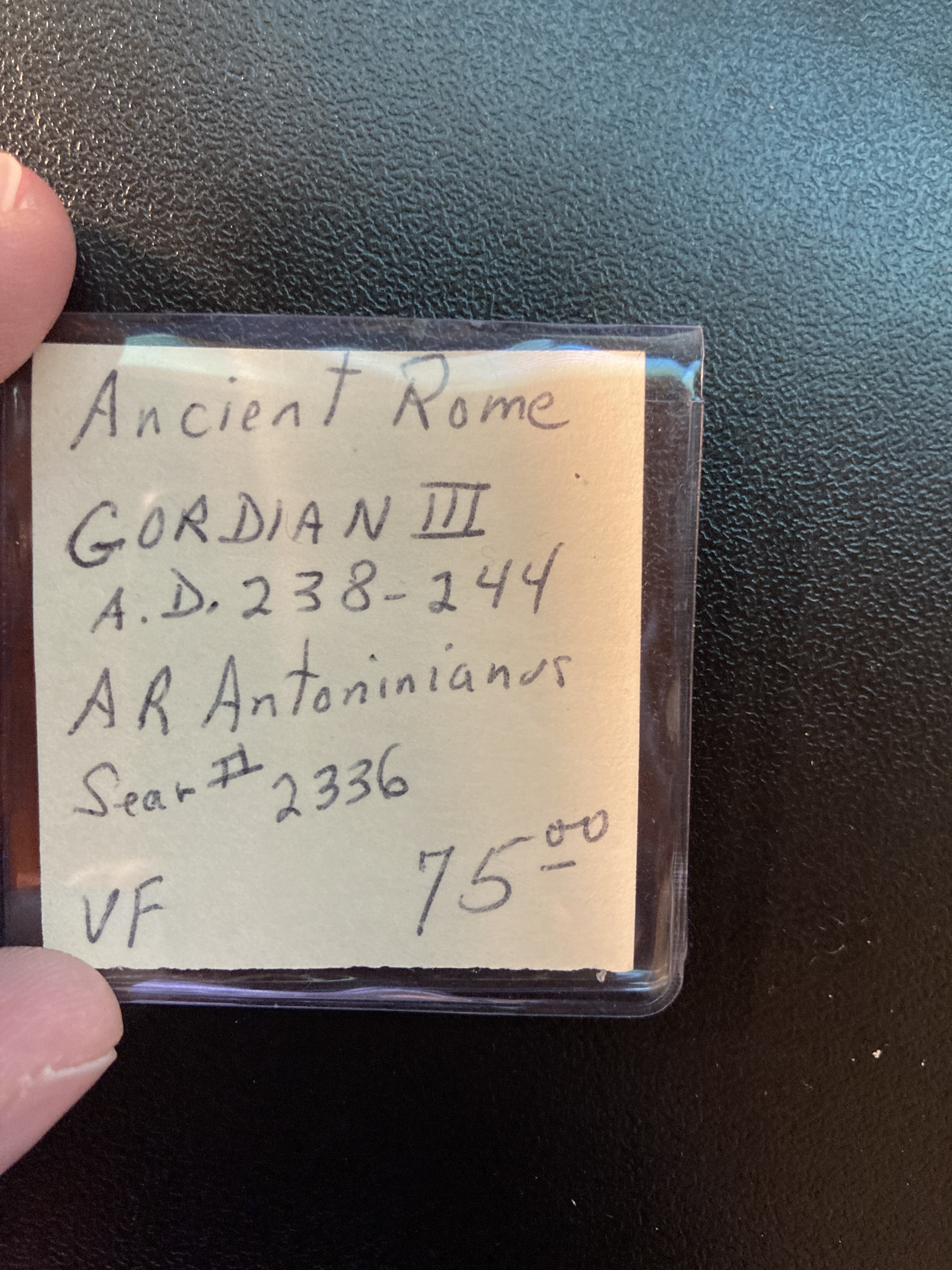Identification Confusion for Roman Coin
 NumisLearner
Posts: 7 ✭
NumisLearner
Posts: 7 ✭
Hello,
I have some experience collecting modern U.S. and foreign coins (mainly 20th and 21st century, with the occasional 18th and 19th century coin). My friend gave me a Roman coin from the 3rd century as a birthday gift. Very exciting! But I'm having trouble identifying it. I have attached images of the obverse, reverse, and some handwritten information from the coin store. My phone camera isn't great; I might be able to get help from a friend if you need better images.
My point of confusion is that the handwritten notes indicate it is a silver (AR) Antoninianus from Gordian III, but the Sear number provided is actually for a gold (AV) quinarius from Maximinus I. I am using Roman Coins and Their Values by David R. Sear. Fourth revised edition, 1988. I checked it out from a library.
Chronologically, this difference in emperors is by less than a decade, but the discrepancy in both emperor and coin denomination make this seem pretty significant.
Please help me identify this coin.
Thank you


Comments
Just as the note on flip says, it's a Gordian III antonianianus. This is a very easy emperor to find, especially on an antonianianus .
Here are the notes on Gordian III from my notebook:
Gordian's grandfather and uncle were also named "Gordian." They were numbers I and II. They ruled as co-emperors for only 21 days. Their coins are very scarce and expensive.
This is only a piece of the history of the year 238. That year there were six Roman emperors. Two sets of them were co-emperors.
Sear numbers for Roman coins differ between the third, fourth and millenial (fifth) editions. This coin would be number 2336 in the third edition, but some other number in the fourth and fifth editions. The fifth edition is the one most commonly used nowadays, simply because it has far more coins in it (it's a five-volume catalogue, rather than just a single book).
I can't quite work out which reverse type you have and don't have a third edition Sear to look up the number. I think it's PROVIDENTIA AVG (which would be Sear 5th edition number 8655 or thereabouts) but I'm not quite sure. Can you take a clearer picture of the coin, outside of the flip?
Roman emperor Marcus Aurelius, "Meditations"
Apparently I have been awarded the DPOTD twice.
2336 in the 3rd edition is actually à G III antoninianus with IOVI CONSERVATORI reverse
PS : I don't know why my above comment gets out so big !!
Here it is from my own trays
Gordian III, Antoninianus - Rome mint, 1st emission AD 05-12/238
IMP CAES M ANT GORDIANVS AVG, radiate, draped and cuirassed bust of Gordian III seen from behind
IOVI CONSERVATORI, Jupiter standing left, holding thunderbolt and sceptre, a small figure of the Emperor at his feet
5,33 gr
Ref : Cohen # 105 (3), RIC # 2, RCV # 8614, Michaux # 293
Maybe if was added via Paste and not by selecting the option on the right-click dialog: "Paste as plain text" this might help.
Hello, I was suspicious the Sear numbers might differ between editions, since that seems like the most straightforward explanation of the discrepancy. But I talked myself out of it, since I felt like such a discrepancy would defeat the purpose of a catalog system.
I have attached better photos, which I took with a friend's phone, and outside of the coin flip.

Hello, thanks for the clarification.
I have some limited experience with identifying what I consider hard-to-identify 18th-20th century foreign coins using just resources available for free on the internet, and I concluded that my coin best matches the Iovi Conservatori coin from Numista: https://en.numista.com/catalogue/pieces280730.html. I made this identification based on the partially legible reverse on my coin.
This was before I checked out the 4th edition from my library.
So it seems we have a consensus on this identification.
Ah, that's a IOVI CONSERVATORI reverse. That would be Sear 8614 in the fifth edition.
As for "why change the numbers with each edition", yes it did cause some annoyance each time - and has led to coin dealers and collectors generally not relying on Sear numbers any more.
The Sear catalogue was originally intended as basically a coin dealer's price list, and the earlier editions only tended to include the most common types and varieties that the dealer was likely to have in stock. There were a lot of coins bought and sold back then that had to be listed as "similar to Sear 1447", for example, or even "not in Sear", which are now included with their own numbers.
The fifth edition was written to be far more comprehensive. As the difference between "8614" and "2336" illustrates, compared with the third edition the fifth edition included over 6000 new coin types in between the beginning of Rome and the reign of Gordian III. If you're going to keep the numbering system both simple and chronological in nature, a complete re-numbering was the only option when so many new coins were added.
Roman emperor Marcus Aurelius, "Meditations"
Apparently I have been awarded the DPOTD twice.
Thank you, this is a huge help!
I have a couple more requests, since I borrowed Sear 4th edition.
Can someone please send a verbatim quotation or photo of Sear 8614 in the 5th edition? My library only carries Sear 5th edition in certain volumes, and Volume 3 which covers this time span isn't carried.
Can someone please send a verbatim quotation or photo of Sear 2336 in the 3rd edition? My library does carry this but it would take time to ship, so getting it from you would be faster.
Thanks!
Here they are :
3rd edition
5th edition